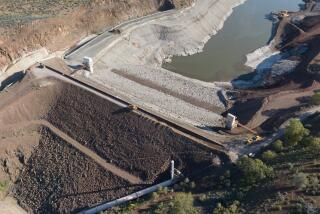Economy Needs a Boost : Burkina Faso Has High Hopes for Dam
- Share via
KOMPIENGA, Burkina Faso — In a natural depression where the Kompienga River meanders between two hills lie Burkina Faso’s hopes for turning a desert green and bringing electricity to its 7 million people.
By the end of 1988, workers are expected to finish work on the nation’s first dam, a dream that is half a century old.
Kompienga is home now to 700 Burkinabe laborers and 300 foreign technicians and their families. Although the project is moving rapidly toward completion, it has been on the drawing board since 1936.
Construction did not get under way until 1985. And now, in the scorching heat, which often hits 120 degrees or more at midday, giant trucks and earthmovers scrape away at the soil.
When French engineers long ago noticed that the area’s contour lines formed a funnel between two mountains about a mile apart, they saw the possibility for a hydroelectric dam that could also serve agricultural purposes.
At the time, the region was known as French West Africa. A dam seemed ideal for the site because it could provide year-round water to the regional agricultural production center, then 10 miles away.
But events intervened and the project got sidetracked. When the French colonial period ended, French West Africa became half a dozen countries with different political and geographical orientations. One was Upper Volta, which now is Burkina Faso, one of a string of countries in the barren Sahel region below the Sahara.
Forgotten Until 1983
The Kompienga dam was forgotten until 1983, when Capt. Thomas Sankara took power in a military coup. Sankara saw in the dam project a way for his desperately poor country, which is about the size of Colorado, to generate electricity and reduce the need to import expensive foreign oil for the country’s electricity generators.
The project started with a budget of $120 million. The death of Sankara in a coup in October has not derailed the plans.
One of the most imposing technical obstacles to be completed is clearing 24,000 acres of trees that are on what will become the bottom of an 84-square-mile lake created by the dam.
Engineers say that unless the trees are cleared, their rotting trunks will eventually jam the turbines in the power-generating station while also raising the water’s acidity to unacceptably high levels.
The dam project still has its skeptics, who maintain that because the region is so dry, the lake may never fill sufficiently for generators to operate at full capacity.
The skeptics also contend that there is a problem with agricultural applications.
“The evaporation level of water here in the Sahel is three times that which falls on the ground,” said Gunther Winkler of the Center for Drought Control in the Sahel.
The Kompienga project is expected to be completed by the end of 1988, and the lake is expected to take two years to fill. But it will bring dramatic change for the people who live here.
More to Read
Sign up for Essential California
The most important California stories and recommendations in your inbox every morning.
You may occasionally receive promotional content from the Los Angeles Times.













